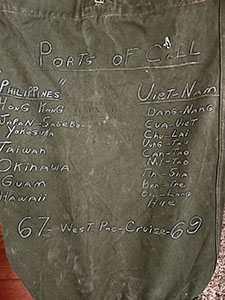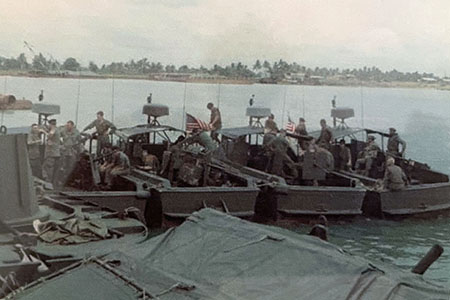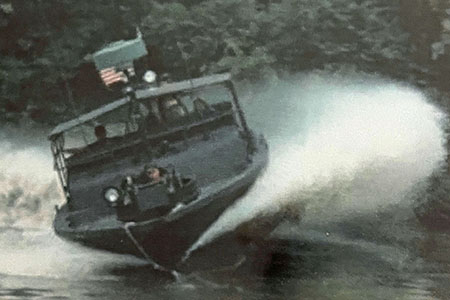Navy Vietnam Olympia Fields, IL Flight date: 05/11/22
By Frank Hauenschild, Honor Flight Chicago Veteran Interview Volunteer
Leon H. Wilson was born and raised in the Englewood neighborhood in Chicago. The middle child of the five children of Leroy and Mattie Wilson, Leon attended Deneen Elementary School and then continued his education at Chicago Vocational High School. As a young adult, Leon was a Boy Scout and joined the Sea Scout Post which met at Navy Pier. Leon explained that he and his friend Chuck “would take a series of buses from Englewood to Navy Pier every Friday night after school and then on weekends to attend meetings.” There they would learn the basics of seamanship and leadership training, and care of their Sea Scout uniforms.
Leon, wanting more adventure than what he was experiencing on the South Side of Chicago, made the decision to join the U.S. Navy at the age of seventeen years old. “It wasn’t too hard to get my parents permission to join the Navy since I was only seventeen; after all my father was a WWII Navy Veteran himself.” Taking his enlistment documents and his parental permission form to his recruiter, he was sworn in as a Naval cadet in Chicago in May, 1967.
Within a few days, he reported to the Great Lakes Training Center to begin his Basic tTraining. “During the three-month training period, we would learn the formalities of the Navy, marching, drilling, marching, more training, and then march some more; that was our day!” Leon explained that each and every cadet had to qualify in swimming to graduate from Basic. He recalled that he had to complete an unbroken lap around the pool to qualify. If you could not qualify, then you were expected to come back to the pool after the formal training day, to train and practice in swimming until you could complete an unbroken lap. “I didn’t initially qualify so I had to come back after training hours, usually after 6:00 p.m., to train. It didn’t take me long to qualify, I think less than a week. But those were a few very long days in Boot Camp!”
Graduating from Basic Training, Leon was sent to Guam for his ship duty assignment. “I was there a few days before my ship arrived.” He was assigned to the USS Sedgwick County (LST-1123) The Sedgwick County was a flat bottom landing ship that could deliver troops, supplies and both wheeled or tracked vehicles to almost any port or beach where the ground was suitable for delivery of the cargo.
From Guam, with Leon aboard, the Sedgwick County sailed to the waters off of South Vietnam. While assigned to the Sedgwick County, Leon traveled to many ports including Hong Kong, the Philippines, Taiwan and of course, South Vietnam where they would pick-up and deliver cargo. “We would pull right up to the shore, open the doors on the front of the LST and unload our cargo,” Leon explained. As the LST was a flat bottom ship, Leon explains “We didn’t need a port or a dock. We could deliver our cargo anywhere: along the ocean shore or river shore. We also made quite a few stops in the Mekong Delta.”
Leon recalled the time the Sedgwick was attacked by the North Vietnamese Army. During the attack, his ship sustained artillery strikes which caused severe damage to the ship. “It was my first combat experience in the Navy and fortunately the attack did not result in any crew injuries. We did receive a Meritorious Unit Commendation for the attack we sustained and completing our mission,” Leon recalled.
One of the other assignments required the Sedgwick County to be anchored in the Mekong Delta. While anchored, the Sedgwick would be a floating refueling and supply stop for the Navy’s river patrol boats which were assigned to the Mekong River and Delta. The river boats, known as the Brown Water Navy, would tie themselves to the Sedgwick for refueling and resupply. Leon recalled one unfortunate day, he and his shipmates had to clear out a refrigeration unit to store a sailor’s body who had been killed in action. Being in the Delta and not near a base, they had to place his body in a “reefer” unit until they arrived in another port to arrange for the transfer of his body home.





Leon recalled that incident had caused him to make a decision. After the artillery attack and viewing the river patrol boats, he decided that he wanted to go “in country Vietnam” with the river patrol boats and make his transition from the “Blue Water Navy” to the “Brown Water Navy.” “I wanted something more, I wanted to be able to move around, see some action and be able to defend myself – I didn’t want to be a sitting duck on a LST anymore,” Leon stated.
Going “in country with the BrownWater Navy” was a totally volunteer request in the Navy. Requesting a transfer, which was granted, Leon then returned to Camp Pendleton, California to be trained in advanced weapons training. Completing his weapons training in December of 1969, Leon returned to South Vietnam and was assigned to a “PBR.”
A PBR was classified as a “Patrol Boat River.” The PBR was a 31-foot-long commercial fiberglass pleasure boat which the Navy retrofitted for river patrol duties. The Navy retrofit consisted of removing the propeller drive and replacing the same with diesel powered water pump jet drives that could propel the PBR up to 28.5 knots (Approx. 33 m.p.h.). For armament, two 50 cc machine guns were typically added to the front and rear of the PBR. Various cannons were also added to various PBRs plus a full complement of small arms such as rifles, shotguns, handguns, and grenades. The PBR typically was manned by a crew of 4-5 personnel in which the boat captain was a First Class Petty Officer. Each crew member was cross-trained and could perform each other’s job. Though the PBR had heavy firepower, Leon recalled “the hulls were still fiberglass.”
Leon stated that they would patrol the waters of the Mekong Delta and the Mekong River. He recalled some of the sampan boat boardings his crew would conduct, which typically took place during daylight hours because boat curfews were in place during the dark hours of the night. If his crew noticed a suspicious sampan or another craft not acting right, they would board the craft and make a complete exhaustive search for illegal personnel, weapons or contraband that could benefit the enemy. Leon explained that upon coming aside a sampan, an armed crew member would board the boat and conduct a total search. Meanwhile, the remaining crew members would be manning their machine guns, ready to open fire if necessary, if the boarding went bad. “It was a risky, dangerous business when boarding; you couldn’t trust anyone on the boat, we were at war and they knew it too. They potentially would do anything to advance their cause,” Leon recalled.
Nighttime patrols were a different situation. Groups of two or more PBRs would leave their base late afternoon, near sunset, and travel up the Mekong River to patrol. With total darkness, the PBR would go near shore and seek some type of shore cover. There they would sit all night and watch for movement. There was not to be any movement by the civilians during the night pursuant to in-place curfews. If there was movement, the crews would open fire on the movement until there was no more movement. Then they would sit and maintain a vigilant search for more movement in their area. The crew members were authorized to open fire upon movement without the PBR’s captain. “The only time we had to check-in before we fired was when we were aware that our troops were near the shoreline. “If we saw movement, we could immediately confirm if the movement was by our troops or not. If not confirmed by friendly troops, we would open fire upon the movement.” At sunrise, and if Leon’s unit fired during the nighttime, they would go ashore to visualize where they were firing to confirm any movement that may have occurred.
Also at sunrise, they would again move up the Mekong River. They would stop at camps or bases set up by the Army or Navy where they could refuel and rearm the PBR. Eventually, they would travel back down the Mekong River to the Delta and their home base. The unit would either tie off to a LST or would dock at a base where they could fuel and supply the PBR and to make any repairs that were necessary. The added luxury with an LST on base is that they could leave the boat, get some real food, shower, and use fixed bathroom facilities. “Our only bathrooms on the PBR were the hulls of the boat,” Leon recalled, shaking his head.
When the war was winding down, Leon became a Navy advisor. Instead of being part of a crew consisting of Navy personnel, we now had troops from the South Vietnamese Navy manning the PBRs with one, or maybe two Navy personnel. To be an advisor, Leon had to obtain official security clearance in order for him to be able to man his PBR. As an advisor with South Vietnamese personnel manning the boat, PBRs could travel to the Cambodian border. “I guess I can say it now as everyone knows, we did travel the Mekong River into Cambodia. We knew we were in Cambodia as the river scenery changed. The trees and jungle coverings were vivid colors of green, not the browned-out areas in South Vietnam that were sprayed with Agent Orange,” Leon stated. Though the war was winding down as to U.S. involvement, the war was still on. Leon recalled a harrowing attack on his patrol when returning to South Vietnam from Cambodia one morning in May, 1970. “They knew we were there and they were waiting for us,” Leon recalled, preferring not to discuss that event any further.
During his tenure in Vietnam, Leon did get his two weeks of R&R. Instead of going to Australia, Taiwan, or Hawaii, he chose to stay in country and spent his two weeks in Saigon, now Ho Chi Minh City. “It was a beautiful city; I ate well, relaxed and enjoyed the sights,” Leon stated as he showed me his Saigon pictures. “I regret not taking more photographs when I was in Vietnam.”
Leon remembered being discharged from the Navy in December, 1970. He flew out of South Vietnam and landed in California where he was discharged. Over four years had passed since he had enlisted with the Navy as a 17-year-old cadet. He flew back to Chicago as a Navy Veteran and happily returned home.
Leon went on to apply for employment with the U.S. Postal Service which turned into a career for him. Through the years, he was a postal clerk in the beginning, then became the manager for post offices on the South Side of Chicago. He was promoted to Post Office Analyst, then acted as Manager of Distribution Operations. Leon retired as a Senior Manager of Distribution Operations in 2005 after a 34-year career.
Once back home, he also joined the Navy Reserves where he was assigned to an Air Squadron which took him to Hawaii and to Taiwan during Operation Desert Storm. Leon served in the Navy Reserves for twenty years.
Leon now enjoys retirement with his wife, Marguerita, in their home in Olympia Fields, Illinois. He enjoys spending time with his children, Leon, Andre and Martin, his stepdaughter, and his 9 grandchildren and his 6 great-grandchildren. Still having a love for the “Blue Water,” Leon and his wife have enjoyed many cruises together and they look forward to future cruises.
Thank you Petty Officer First Class Leon H. Wilson for your dedicated and courageous service to our country. Enjoy your well-deserved Honor Flight with your fellow veterans!


